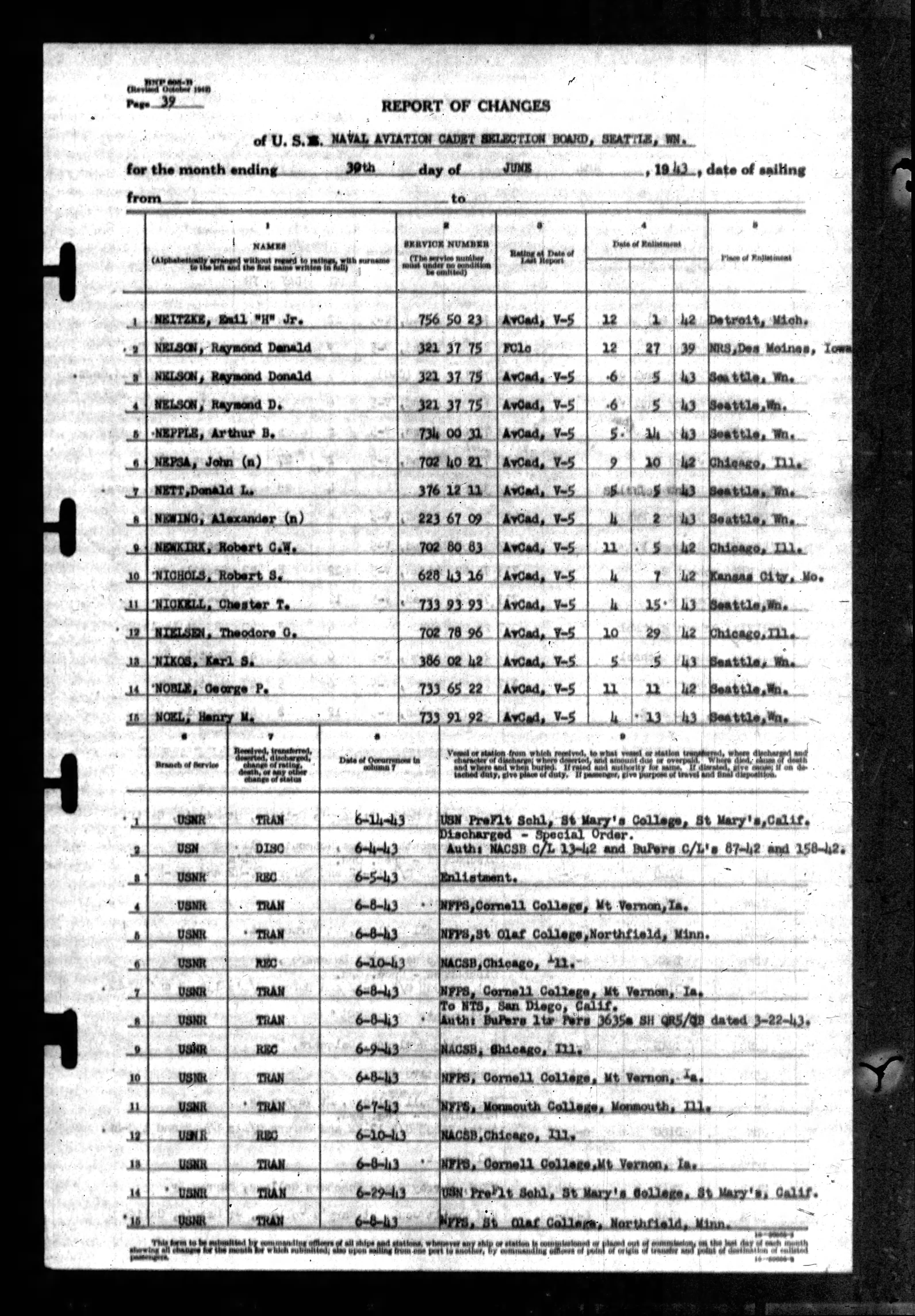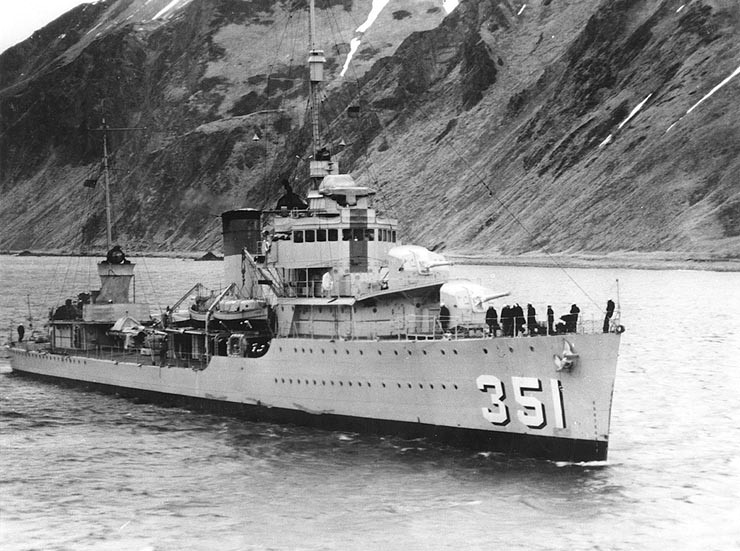Raymond Donald Nelson (August 9, 1920-March 8, 1994)
By Lucas Pettinati
Early Life
Raymond “Ray” Donald Nelson served in the US Navy during World War II. He was born on August 9, 1920, to Raymond W. Nelson and Lydia Seigel, a Protestant family in Brooklyn, IA.1 He had four siblings: Lenora, Anna,Greta, and Fred.2 Raymond Nelson’s father immigrated from Denmark. Nelson grew up on an Iowa farm.3
Service
Raymond Nelson enlisted in the Navy in Des Moines, IA, on December 27, 1939, less than three months after war broke out in Europe.4 At the time, the United States was still attempting to remain neutral in the conflict, not officially entering World War II until after the Japanese attack on Pearl Harbor December 1941. Thus, Nelson served a full two years in the US Navy prior to the US entering, giving him time to reach the rank of Lieutenant Junior Grade (LTJG). LTJG is the second commissioned officer rank in the US Navy and it usually takes two years to achieve LTJG after receiving commission as an Ensign. LTJG lead seamen and petty officers in specific divisions.5 Nelson arrived aboard the USS MacDonough (DD-351) on June 13, 1940, after several months of training.6
The MacDonough, pictured here, was one of eight Farragut-class post-WWI destroyers. The relatively lightly armed small vessel operated out of San Diego until October 12, 1939, when it was attached to Destroyer Squadron 1 out of Pearl Harbor, HI. Nelson enlisted and joined the crew during this period of relative calm in 1939. During the December 7, 1941, attack on Pearl Harbor two years later, the MacDonough shot down a single Japanese attack aircraft, then participated in the scouting operations to locate the enemy task force.7 Nelson stayed on board the destroyer throughout the battle and subsequent scouting operations in the Pacific during 1941, as well as escorting Allied supply ships in the region.8 The ship also supported Allied airstrikes against Bougainville, Salamaua, and Lae. The MacDonough took part in the vital invasion of Guadalcanal, providing cover from airstrikes against the landing US Marines. Nelson engaged in heavy combat with the Japanese Navy during the Battle of Savo Island off the coast. This area became known as Iron Bottom Sound due to the large number of sunken U and Japanese vessels.9
Raymond was still on the MacDonough when it sailed from a port in Alaska’s Aleutian Islands to defend against Japanese invasion attempts. While patrolling off Attu Island on May 10, 1943, the ship collided with the USS Sicard, an older Clemson-class destroyer, and was forced to retire to port for repairs until September 1943.10 Nelson would not return to action with the vessel in the South Pacific. He was discharged under special order by the Naval Aviation Cadet Selection Board in Seattle, WA on the June 30, 1943.11 Research suggests that this discharge may indicate a change of position after the accident in Alaska. Nelson appears on board the Cleveland-class light cruiser USS Birmingham (CL-62) from 1944 until the end of the war. His rating onboard the Birmingham was M2c (Metalsmith 2nd class).12 Raymond Nelson left official military duty as a Lieutenant Junior Class on October 3, 1946.13
Post Service
About a year before being discharged from the US Navy, Nelson married Eleanor Elizabeth Wylie on December 29, 1945. They lived, for a time, in Pensacola, FL. They moved to Fort Pierce, FL in 1949.14 Nelson remained there until his passing on March 8, 1994, at the age of 73. His spouse, Betty Nelson, was a Fort Pierce native. His sons, Donald and Derrick, as well as one of two daughters, Ericka, still live in Fort Pierce. Nelson’s other daughter, Deborah, now lives in Raleigh, NC. Nelson owned and operated a chemical supply business, Economy Chemical, where some of his four children now work. He was also a member of the Pearl Harbor Survivors Association, the Retired Officers Association, and the Treasure Coast Coin Club.15 He is buried in Florida National Cemetery in Bushnell, FL.16
Endnotes
1 “Iowa, State Census Collection, 1836-1925,” database, Ancestry.com, https://www.ancestry.com (accessed July 3, 2017) entry for Raymond D Nelson.
2 “1940 United States Federal Census,” database, Ancestry.com, https://www.ancestry.com (accessed July 3, 2017) entry for Raymond W Nelson, Year: 1940; Census Place: Bear Creek, Poweshiek, Iowa; Roll: T627_1200; Page: 2A; Enumeration District: 79-2.
3 Ibid.
4 “Pearl Harbor Muster Rolls,” database, Fold3.com, https://www.fold3.com (accessed April 10, 2017) entry for McDonough (DD-351), Year 1941, Page 4.
5 “Navy Lieutenant Junior Grade,” Military-Ranks.org, accessed July 3, 2017, https://www.military-ranks.org/navy/lieutenant-junior-grade.
6 “Pearl Harbor Muster Rolls.”
7 “MacDonough (DD-351),” Naval History and Heritage Command, accessed April 10, 2017, https://www.history.navy.mil/research/histories/ship-histories/danfs/m/macdonough-iii.html.
8 “WWII Navy Muster Rolls,” database, Fold3.com, https://www.fold3.com (accessed April 10, 2017) entry for McDonough (DD-351), Year 1943. Page 466.
9 “MacDonough (DD-351),” Naval History and Heritage Command; “WWII Navy Muster Rolls.”
10 “MacDonough (DD-351),” Naval History and Heritage Command.
11 “WWII Navy Muster Rolls.”
12 “WWII Navy Muster Rolls,” database, Fold3.com, https://www.fold3.com (accessed April 10, 2017) entry for Birmingham (CL-62), Year 1945, Page 39.
13 Iowa, World War II Bonus Case Files, 1947-1954,” database, Ancestry.com, https://www.ancestry.com (accessed July 3, 2017) entry for Raymond Donald Nelson.
14 Raymond D. Nelson, National Cemetery Administration, National Gravesite Locator, https://gravelocator.cem.va.gov.
15 Ibid.
16 Ibid.
© 2017, University of Central Florida




